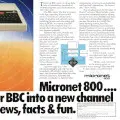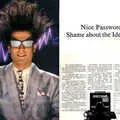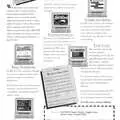Micronet Advert - 1st June 1989
From Popular Computing Weekly
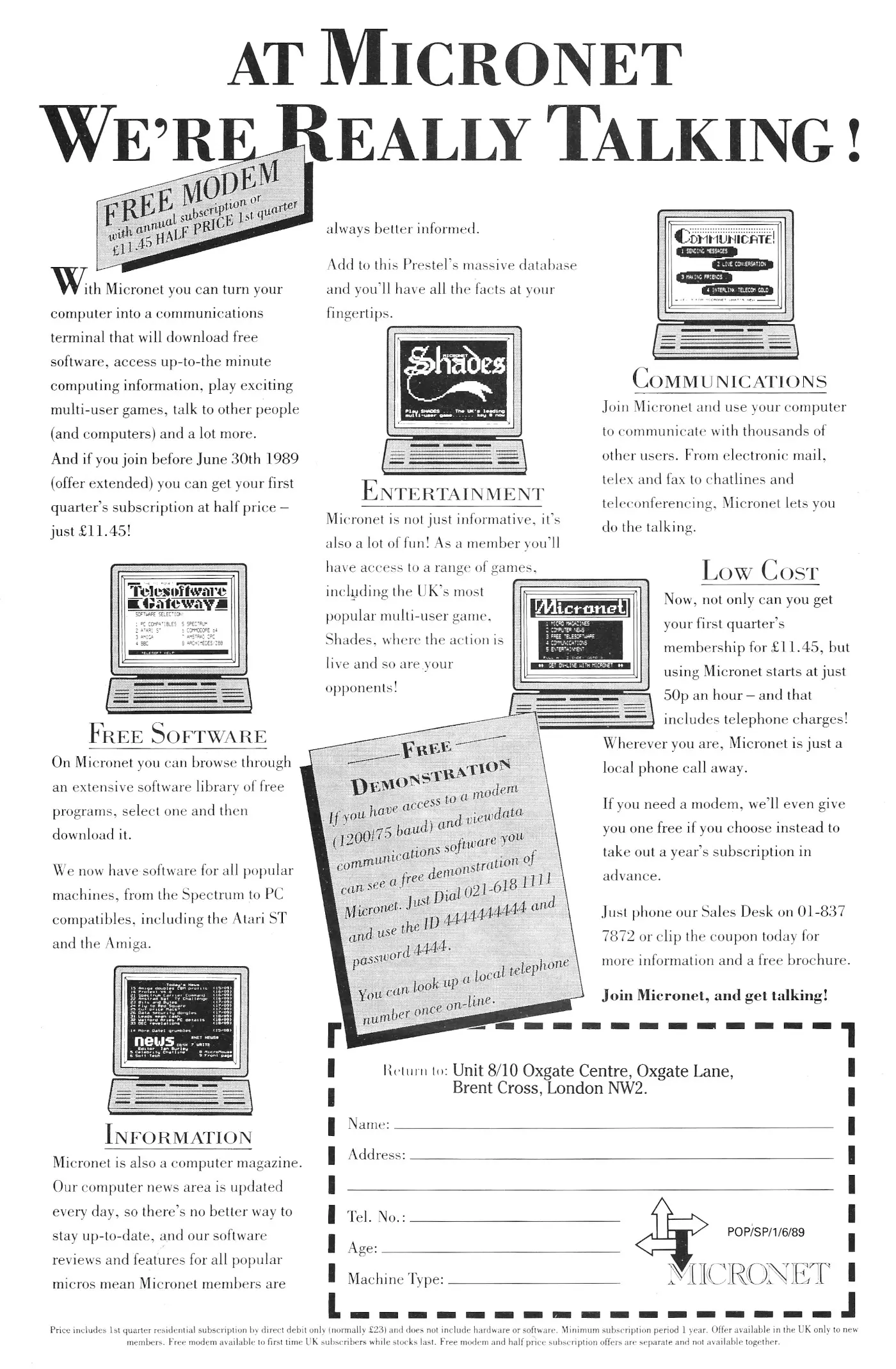
At Micronet we're really talking
Launched at the beginning of 1983, Micronet was a Viewdata dial-up service created as a Prestel project of East Midland Allied Press, the publishing and printing group.
Micronet had its roots in the purchase of ECC - the publisher of Educational Computing - which brought with it Richard Hease, who was also a partner in modem manufacturer Prism Microproducts.
EMAP's Telemap group, as it had become known, subsequently purchased Bob Denton's Prestel magazine Electronics Insight. Denton had previously been associated Tandata's also-failing Prestel service.
Hease, who had been given the job of making EMAP's existing, but loss-making, Prestel service work, came up with the idea of a computer user's database, offering telesoftware, news and on-line shopping, and managed to get the backing and investment of both Prestel and the Department of Industry.
This came together with Denton's Electronics Insight service to create the new, improved, Micronet 800 in a matter of weeks, with around 3,000 pages initially[1].
By the time of its fifth birthday in March 1988 - just over a year before this advert - it was up to 50,000 pages, which was nearly a sixth of the whole of Prestel.
Electronic messaging, for a price
New subscribers were tailing off though, so Micronet was starting to look for new markets, such as its Bizznet service, with a 4p per hour surcharge.
Bizznet also included what Micronet called "teleconferencing" - not in the video sense, but based on the chatrooms that had been pioneered by CompuServe in the US.
This was at a time when electronic communications in general were catching on, thanks largely to a surge in the availability of cheap (or at least cheaper) modems. Even Prestel's primitive email system was seeing around 139,000 messages sent each week[2].
When Prestel first launched in 1979, it already had the inherent ability to send email but the feature was kept largely secret because of political and labour considerations - at the time the nationalised and unionised GPO was running the system and it wanted to protect its postal monopoly.
The US Postal Service faced a similar threat, but over there the networks - which included the two biggest, The Source and MicroNET - were private so they just went ahead an implemented email anyway[3].
Micronet initially cost £66 per year to subscribe (£260 in 2025), but was down to £52 a year shortly afterwards[4]. It was also subject to hourly phone charges of at least 40p an hour, rising to 60p by 1988 (this was the cheapest rate, available during evenings and weekends), which was nearly £1.50 per hour in 2017 terms.
On top of that, there were often pay-per-view charges on content for the wider Prestel - up to a maximum of 50p per frame - although most of Micronet was "free".
If nothing else, it was an order of magnitude cheaper than the House of Commons' online information system, launched in early 1981. Although free to parliamentarians, this was also available to the wider masses, as long as they could stump up the £1,990 (£10,600) annual subscription and £55 (£290) per hour connection fee[5].
By now, subscription was down to £45.80 a year, which combined usage and phone charges of "only" 50p an hour - this was possible as all UK users could now dial up Prestel using local-rate calls.
Micronet and telesoftware
It was also possible to download software from Micronet, with Acorn being an active promoter of Prestel adapters for the BBC Micro for this reason.
Twenty-five new programs were added to the library in March 1983 alone, although unlike the other supported computers which had at least 100 programs each, finding copyright-free software for the BBC Micro was proving somewhat harder[6].
Acorn was selling both add-on adapters and even partnering with spin-off company Torch, which built a whole computer - the Torch Communicator - around a BBC with Prestel.
Acorn also launched its own 1000-page Viewdata service in April 1985, containing information on stuff like product news, software, upgrades and dealer locations.
It ran on three BBC Micros linked via Econet to a hard disk unit and was available 24 hours a day, seven days a week[7], unlike many data services and bulletin boards of the time which were run by enthusiasts using their parents' phone, so were often only available from 6pm to 6am.
By 1987, major software houses were signing deals with Micronet to produce telesoftware for the service. This included Firebird and Code Masters, whose signing-up in November 1987 gave subscribers access to any of their "hot off the press" titles with up to 25% off the usual price of £1.99.
There were no immediate plans to sign up more budget software providers, although Micronet was keen to eventually have as many as possible on its books.
Firebird's publisher Chris Smith enthused "budget software is an impulse buy and telesoftware is the ideal environment for it. Priced as low as £1.50 on Micronet, Firebird's software is unbeatable"[8].
When Micronet launched, subsidised networking interfaces comprising an acoustic modem, power pack, cables and software were offered to the first 10,000 subscribers for £49 (£190).
In February 1983, adapters were available for the BBC Micro and the Tandy "CoCo", with Spectrum and Dragon versions supposedly becoming available in March[9].
Personal Computer News was also reporting in March that the Commodore PET, Apple's I and II and Research Machines' 380Z as well as Tandy's TRS-80 models 1 and 2 could be hooked up.
The advert suggests that there were 50,000 Prestel subscribers as at June 1985, of which 20,000 were accounted for by Micronet (at its height)[10], whilst the highest number of subscribers Prestel ever had was thought to be about 90,000.
Despite the relatively low number of subscribers, Micronet did claim the milestone of being the first Prestel service to register over 1 million accesses in a single month in 1983 - just as three more micros were confirmed as able to connect to the service - the Spectrum (via a Prism VTX 5000 modem), Apple II and TRS-80[11].
Reviewing the VTX5000 in Personal Computer News, John Lettice (who would later write for The Register) summed up:
"if the Prism does the same for other micros, the acoustic modem would certainly seem to be on the way out, and as far as the Spectrum is concerned the VTX5000 represents a giant step. It isn't simply a tool for letting the machine be used with Micronet - it's a route out in to the big wide world and it will at least start the Spectrum off in the direction that micros will be taking through the home information revolution"[12].
Also available were adapters for Commodore's 64, 500, 700, 3000, 4000, and 8000 machines and some more esoteric micros, like ICL, RAIR, Superbrain, Nascom, NewBrain, Lynx and Osborne.
Micronet also won a "Recognition of Information Technology Award", or RITA - a sort of IT Oscar - for Systems Innovation of the Year at the 1984 Which Computer? Show[13].
Despite the relative success of Micronet, Prestel never really caught on. It was sold off by BT in 1994 - the year before that whole "World Wide Web" thing really started to kick off in the UK.
Radio Ham
Meanwhile, another option for the seriously hard-core Bulletin Board System (BBS) user, or just those worried about racking up huge phone bills - especially if you wanted to do anything as exotic as contact a BBS that was abroad - was packet radio.
This used a version of the X.25 packet-switching protocol - hence the name "packet radio" - called AX.25, a system similar to the X.25 found in leased-line networks and much like that used in PSTN telephone systems.
Another alternative was something like the Dutch Computer World interface for the humble VIC-20, which allowed the 3.5K micro to receive, decode and transmit Morse code or RTTY (Radio Teletype), the latter from 45 baud up to 300 - the average speed of a regular dial-up modem at the time[14].
The drawback of connecting over radio was that it did require yet another modem as well as an amateur radio licence, which required six-month-long City & Guilds courses as well as £12-per-annum fees[15]. Nevertheless, modems were available such as one from unfortunately-named Vomek Software which retailed for about £300 (£1,200).
Whilst connecting to 1200-baud half-duplex packet radio (which meant it could do 1200 baud but in only one direction at a time) was considered perfectly fine, less clear was the legality of setting up a BBS on packet radio, as the regulations implied that the licenced operator must be in attendance[16].
The U.S. was much less regulated in this respect. In Vermont, for example, a network of Commodore 64s had been set up to relay tourist information over the air, and it was possible to receive financial news over the air in 36 major cities across the country.
Modems in the States were also significantly cheaper, costing around $200, or about £530 in 2025 money, which helped the market significantly. The UK market was still much smaller, but nevertheless American modem giant Hayes (which gave its name to the control protocols used by almost every modem made since) was on the cusp of launching its modems in the UK during the early summer of 1985.
Hayes' first product was to be a 1200 baud full-duplex modem, but the labyrinthine BABT approval process was being blamed for delaying the launch.
The Brentford Boys shake things up, again
The disparity between UK and US modem prices was so bad that there was even an in-depth article about the situation in August 1988's Personal Computer World, where Peter Tootill questioned the difference.
One such example he gave was Dowty's Trailblazer, which retailed in the UK for an eye-watering £1,795 (£6,310 in 2025), even though this was merely a re-badged imported Telebit modem which sold for $1,200 in the US, which was less than £700 (£2,810) at the time, or under a half the cost of the UK version.
It was suspected that the small cost of adapting to BABT requirements would not even remotely account for the difference.
When this point was put to Martin Ansell of Dowty, the somewhat feeble excuse offered was that the company was not "out to make a quick buck" but that it had to "cover costs of developing the UK adaptation of the modem and of initial marketing".
David Baxter, marketing director of Miracom - the company previously known as Miracle Technology - suggested that the reason was that the UK market was "different" to the US, which was much more competitive and where a far higher proportion of computer owners also had modems.
So it was all entirely justifiable as supply/demand capitalism in action then.
It was possible to get a better deal if the buyer was or wanted to become a Sysop, or System Operator - the person running a BBS.
Here, modem manufacturers seemed unsurprisingly keen to get their products in place, with US Robotics offering 50% off a modem for bulletin board operators.
There was a dark side to this, because whilst USR's offer meant that many BBS systems were using its modem, the standard the company had chosen for the then-popular 9600 bits per second connection speed was V.29.
This was really meant for leased lines - and so it had to run half-duplex when on regular telephone lines - but it was cheaper than the official CCITT-approved standard for dial-up modems, V.32, and so USR was using it and dragging loads of users over to its non-standard choice.
However, even this was probably an improvement over Telebit's Trailblazer, which was using its own entirely proprietary and incompatible protocol.
There were however some cheaper alternatives available, although these were aimed strictly at the PC as they were internal modems which fitted into a free slot on the PC motherboard, rather than being housed in an external box with flashing lights and its own power supply.
They included the £199 V.21/V.22 Stradcom and the £299 Quadcom, which added V.23 and V.22bis, but the most significant entry into the market was Amstrad's MC2400 at £199.
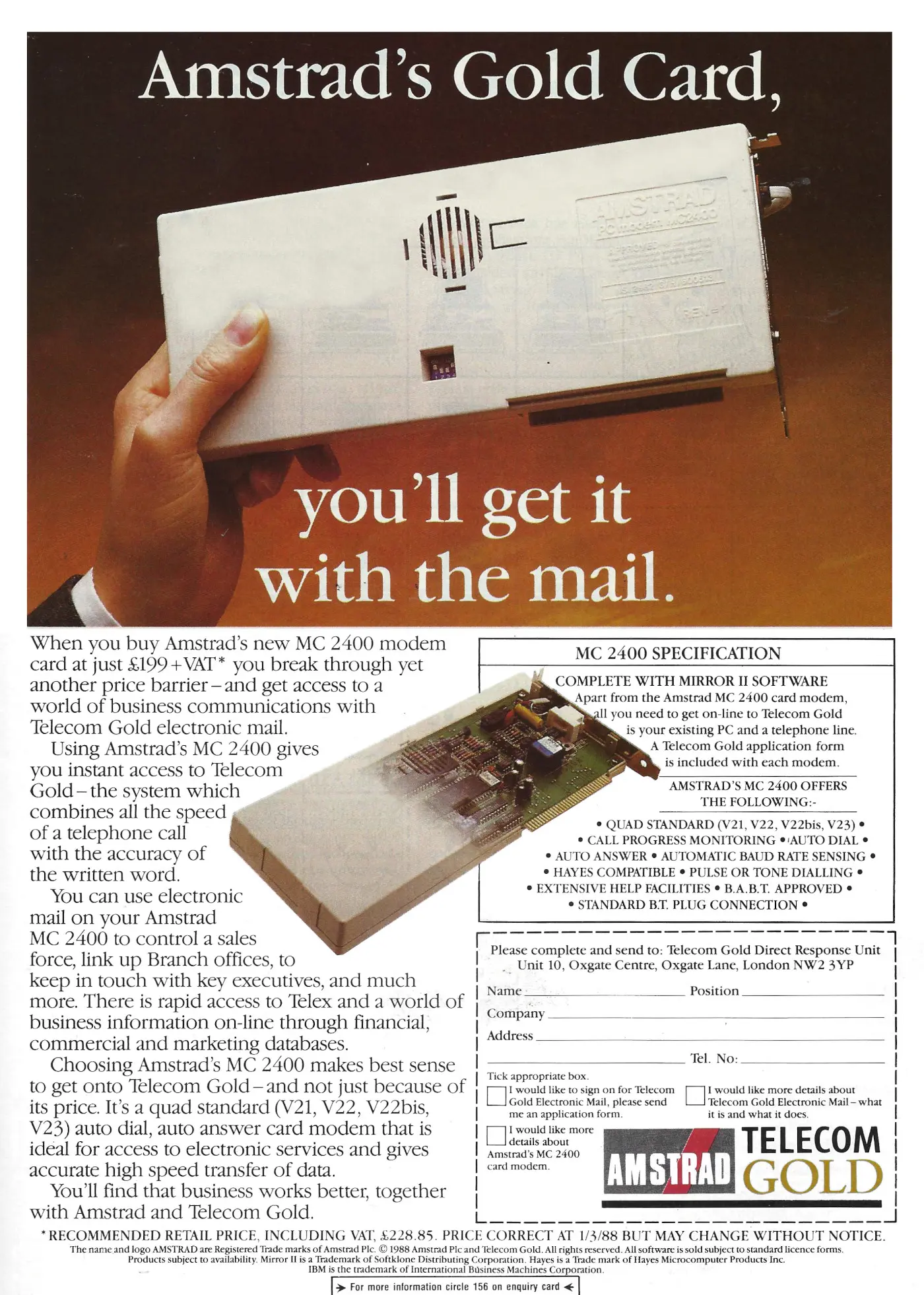
Amstrad's MC2400 modem for £199 + VAT, a groundbreaking price for a modem at the time. From Practical Computing, April 1988
Amstrad was already selling its portable PPC micros, two models of which included a four-speed modem, but at a price which was not much different to that which companies like Dowty and co were touting for just their modem.
It clearly wouldn't be long before Amstrad pulled the modem out and sold it separately, which it did - after the obligatory BABT delay - sometime in the summer of 1988.
Bundled with a free copy of the Mirror II modem control program, itself worth £70, the MC2400 left out a few specialist features, like Prestel's 1200/75, Microcom Network Protocol (MNP) error correction and some convenient automatic speed sensing, but it otherwise represented what Personal Computer World called an "unbeatable" offer[17].
Farming situation
If being a radio ham wasn't an option for the aspiring Prestel competitor, ACT, the company that acted as distributor for Chuck Peddle's Sirius back in 1982, was offering its own Apricot Xi10S micro which could support up to 8,000 pages of Viewdata information to up to 200 terminals, included full Prestel compatibility.
The base Xi10S came with a 10MB hard disk and 512K RAM, plus colour graphics card, monitor, viewdata software and multiplexor (which allowed multiple simultaneous incoming connections) all for £9,930 (about £39,900 in 2025).
ACT's managing director Tony Bryan said of the price "Until now, businesses requiring such a service have had to invest in minicomputer systems costing upwards of £100,000"[18].
Potential users were expected to be mostly the usual suspects of finance, banks, building societies and travel agents as well as, perhaps optimistically, agriculture. Personal Computer News quipped "we expect the number of farms requiring 200 terminals to be strictly limited".
Similarly, a computer from Acorn spin-off Torch was being used to run a system in the Western Isles of Scotland.
Containing 3,500 pages on a hard disc, some of which was in Gaelic, outlying schools in the remote Western Isles region could connect using their BBC Micros. As of Autumn 1984, 26 schools had the required gear with the remaining 44 expected on-line soon[19].
Date created: 12 February 2024
Last updated: 03 October 2025
Hint: use left and right cursor keys to navigate between adverts.
Sources
Text and otherwise-uncredited photos © nosher.net 2025. Dollar/GBP conversions, where used, assume $1.50 to £1. "Now" prices are calculated dynamically using average RPI per year.
